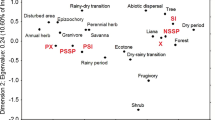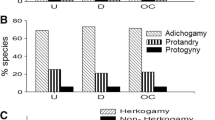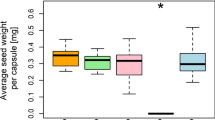Abstract
Breeding systems and mating systems of plants in a previously studied secondary deciduous forest were reanalysed in the context of new data. In this analysis, we increased the number of plant species (up to approximately 25% of the plant species in the community), included other life forms (23 annual and perennial species, plus habitat disturbance categories), and considered information about pollinator specificity. The frequencies of species with different sexual systems in a sample of 51 species were 82% hermaphrodite, 14% monoecious, and 4% dioecious. The frequencies of breeding systems in the sample of 49 hermaphroditic and monoecious species were 53% self-incompatible and 47% self-compatible. Self-compatible species included seven partially self-compatible, three self-compatible non-autogamous, and 13 self-compatible autogamous species. None of the species evaluated proved to be agamospermous. Fifty-five percent of the species tested were obligate outbreeders. The proportion of self-incompatible species was higher among trees and shrubs than among annual herbs. The proportion of self-compatible species for perennial herbs and lianas was not different. The association between annual herbs and autogamy was not strong: seven of 13 species were autogamous, five were partially self-compatible, and one was self-incompatible. The main characteristics or factors associated with breeding system were life cycle and successional stage. Short-lived species were mostly self-compatible, and xenogamy tended to be associated with forest and forest-border. In contrast, pollination specificity and life form were not consistently related to breeding system (self-compatibility or self-incompatibility) and mating system (xenogamy or autogamy).
Similar content being viewed by others
References
Abbott, R. J., Forbes, D. G., 1993: Outcrossing rate and self-incompatibility in the colonizing speciesSenecio squalidus. — Heredity71: 155–159
Allard, R. W., 1975: The mating system and microevolution. — Genetics79: 115–126.
Antonovics, J., 1968: Evolution in closely adjacent populations. V. Evolution of self-fertility. — Heredity23: 219–238.
Arroyo, M. T. K., 1974: Chiasma frequency evidence on the evolution of autogamy inLimnanthes floccosa (Limnanthaceae). — Evolution27: 679–688.
Ashton, P. S., 1969: Speciation among tropical forest trees: some deductions in the light of recent evidence. — Biol. J. Linn. Soc.1: 155–196.
Baker, H. G., 1974: The evolution of weeds. — Annual Rev. Ecol. Syst.5: 1–24.
Bawa, K. S., 1974: Breeding system of tree species of a lowland tropical community. — Evolution28: 85–92.
, 1980: Evolution of diocey in flowering plants. — Annual Rev. Ecol. Syst.11: 15–39.
, 1985: Reproductive biology of tropical lowland rain forest trees. I. Sexual systems and incompatibility mechanisms. — Amer. J. Bot.72: 331–345.
Berry, P., Steyermark, J., 1983: Florula de los bosques decíduos de Caracas. — Mem. Soc. Ci. Nat. La Salle43: (120).
Bullock, S. H., 1985: Breeding systems in the flora of tropical deciduous forest in Mexico. — Biotropica17: 287–301.
Chan, H. T., 1981: Some Malaysian Dipterocarps. III Breeding systems. — Malaysian Forester44: 28–34.
Cruden, R. W., 1977: Pollen-ovule ratios: a conservative indicator of breeding systems in flowering plants. — Evolution31: 32–46.
Devall, M. S., Thien, L. B., 1992: Self-incompatibility inIpomoea pes-caprae (Convolvulaceae). — Amer. Midl. Naturalist128: 22–29.
Ewel, J. J., Madriz, A., Tosi, A. jr., 1976: Zonas de vida de Venezuela. — Memoria explicativa sobre el mapa ecológico, 2nd edn. — Caracas: M. A. C. — FONIAP.
Felsenstein, J., 1974: The evolutionary advantage of recombination. — Genetics78: 737–756.
Flores, S., Schemske, D. W., 1984: Dioecy and monoecy in the flora of Puerto Rico and the Virgin Islands: ecological correlates. — Biotropica16: 132–139.
Grant, V., 1981: Plant speciation, 2nd edn. — Columbia, New York: Columbia University Press.
Hernández, H. M., Carreón, A. Y., 1987: Notas sobre la ecología reproductive de árboles en un bosque mesófilo de montaña en Michoacán, México. — Bol. Soc. Bot. México47: 5–35.
Hokche, O., 1984: Estudio comparativo de la biologío reproductiva y depredación de semillas de algunas species del géneroBauhinia L. (Leguminosae-Caesalpinioideae). — Trabajo especial de grado, Universidad Central de Venezuela, Facultad de Ciencias, Escuela de Biología, Caracas, Venezuela.
Hokche, O., Ramírez, N., 1994: Biología reproductiva deSolanum gardneri Sendth. (Solanaceae). — Acta Científica Venezolana45 (Suppl. 1): 37.
Ibarra-Manríuez, G., Oyama, K., 1992: Ecological correlates of reproductive traits of Mexican rain forest trees. — Amer. J. Bot.79: 383–394.
Jain, S. K., 1976: The evolution of inbreeding in plants. — Annual Rev. Ecol. Syst.7: 469–495.
Janzen, D. H., 1970: Herbivores and the number of tree species in tropical forest. — Amer. Naturalist104: 501–528.
Jarne, P., Charlesworth, D., 1993: The evolution of the selfing rate in functionally hermaphrodite plants and animals. — Annual Rev. Ecol. Syst.24: 441–466.
Kress, W. J., 1983: Self-incompatibility in Central AmericanHeliconia. — Evolution37: 735–744.
Levin, D. A., 1972: Competition for pollinator service: A stimulus for the evolution of autogamy. — Evolution26: 668–669.
, 1975: Pest pressure and recombination systems in plants. — Amer. Naturalist190: 437–451.
Levins, R., 1968: Evolution in changing environments: some theoretical explorations. — Princeton, New Jersey: Princeton University Press.
Lloyd, D. G., 1979: Some reproductive factors affecting the selection of self-fertilization in plants. — Amer. Naturalist113: 67–79.
, 1980: Benefits and handicaps of sexual reproduction. — Evol. Biol.13: 69–111.
Maynard Smith, J., 1974: Recombination and the rate of evolution. — Genetics78: 299–304.
McDade, L. A., 1985: Breeding systems of Central AmericanAphelandra (Acanthaceae). — Amer. J. Bot.72: 1551–1521.
McMullen, C. K., 1987: Breeding systems of selected Galapagos Islands angiosperms. — Amer. J. Bot.74: 1694–1705.
Opler, P., Bawa, K. S., 1978: Sex ratios in some tropical forest trees. — Evolution32: 812–821.
, 1980: Plant reproductive characteristics during secondary succession in neotropical lowland forest ecosystems. — Biotropica12: 40–46.
Parrish, J. A. D., Bazzaz, F. A., 1982: Competitive interactions in plant communities of different successional ages. — Ecology63: 314–320.
Price, S. C., Jain, S. K., 1981: Are inbreeders better colonizers? — Oecologia49: 283–286.
Raimundez, E., Ramírez, N., 1994: Biología reproductiva de una hierba perenne:Hipoxis decumbens L. — Acta Ci. Venez45: (Suppl. 1): 37.
Ramírez, N., 1988: Como evaluar el sistema de polinización a nivel comunitario. — Acta Ci. Venez.39: 304–305.
, 1990: Reproductive biology of a tropical palm swamp community in the Venezuelan Llanos. — Amer. J. Bot.77: 1260–1271.
, 1994: Plant reproductive biology of herbaceous monocots in Venezuelan tropical cloud forest. — Pl. Syst. Evol.190: 129–142.
Renner, S. S., Ricklefs, R. E., 1995: Dioecy and its correlates in the flowering plants. — Amer. J. Bot.82: 596–606.
Ruíz-Zapata, T., Arroyo, M. K., 1978: Plant reproductive ecology of a secondary deciduous tropical forest in Venezuela. — Biotropica10: 221–230.
Schemske, D. W., 1978: Evolution of reproductive characteristics inImpatiens (Balsaminaceae): The significance of cleistogamy and chasmogamy. — Ecology59: 596–613.
Schnee, L., 1984: Plantas comunes de Venezuela, 3rd edn. — Caracas: Universidad Central de Venezuela, Ediciones de la Biblioteca.
Sobrevila, C., Arroyo, M. K., 1982: Breeding systems in a montane tropical cloud forest in Venezuela. — Pl. Syst. Evol.140: 19–37.
Sokal, R., Rohlf, F., 1969: Biometry. — San Franciso, California: Freeman.
Solbrig, O. T., Rollins, R. C., 1977: The evolution of autogamy in species of the mustard genusLeavenworthia. — Evolution31: 265–281.
Stebbins, G. L., 1957: Self fertilization and population variability in the higher plants. — Amer. Naturalist91: 337–354.
, 1970: Adaptive radiation of reproductive characteristics in angiosperms, I: Pollination mechanisms. — Annual Rev. Ecol. Syst.1: 307–326.
Steyermark, J. A., Huber, O., 1978: Flora del Avila. — Caracas: Sociedad Venezolana de Ciencias Naturales.
Tamayo, F., 1943: Notas ecológicas Venezolanas: proceso de despoblación y reposición vegetal de las colinas de Caracas. — Caracas: Escuela Técnica Industrial, talleres de artes gráficas.
Tanner, E. V. J., 1982: Species diversity and reproductive mechanisms in Jamaican trees. — Bot. J. Linn. Soc.18: 263–278.
Thomas, S. C., LaFrankie, J. V., 1993: Sex, size, and interyear variation in flowering among dioecious trees of Malayan rain forest. — Ecology74: 1529–1537.
Vidal, M. C., 1989: Ecología de polinización de un bosque decíduo secundario. — Trabajo especial de grado, Universidad Central de Venezuela, Facultad de Ciencias, Escuela de Biología, Caracas, Venezuela.
Waller, D. M., 1979: The relative costs of self- and cross-fertilzed seeds inImpatiens capensis (Balsaminaceae). — Amer. J. Bot.66: 313–320.
Xena de Enrech, N., Ramírez, N., Sobrevila, C., 1988: Natas sobre la dinámica reproductiva de una comunidad vegetal de vega de rio. — Actes Simp. Int. Bot.Pius Font i Quer 2: 69–82.
Author information
Authors and Affiliations
Rights and permissions
About this article
Cite this article
Jaimes, I., Ramírez, N. Breeding systems in a secondary deciduous forest in Venezuela: The importance of life form, habitat, and pollination specificity. Pl Syst Evol 215, 23–36 (1999). https://doi.org/10.1007/BF00984645
Received:
Revised:
Accepted:
Issue Date:
DOI: https://doi.org/10.1007/BF00984645




